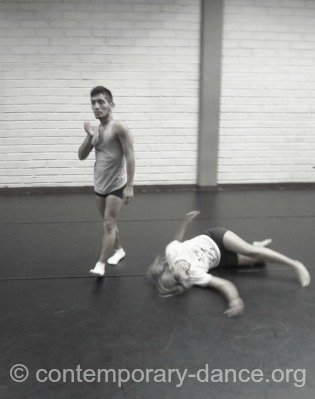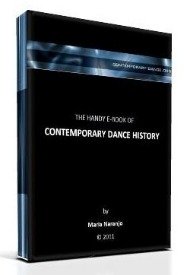Ideas for Dance Composition
When playing the role of the choreographer, one of the ways to start a dance composition process is to use guidelines that will ask the dancers to produce movement. Depending on the type of dance one is creating, some procedures are more popular than others, but in a general way, we all usually rely on ‘inspirational sources’ that serve as the starting point. I’ll try to list some examples below, hoping that you can use them somehow. If not, they may help you find ideas for dance composition projects that you have.
1. The music as a source.
This method is extremely popular. It is so popular that some people even think that this is ‘THE WAY’ to compose dance. It consists of choosing a musical piece and then creating the choreography while listening to it. One could use this method in several ways, that don’t limit to just translate the musical structure, feeling and dynamics to movement. Here are some ideas:
- (The popular method) ‘Translate’ the music: create movements that the music makes you feel, copying rhythm if any, and other musical components.
-‘Go against’ the music: make movements that oppose to what the music is proposing, creating a contrast between music and choreography.
- ‘Create guidelines that link movement to the music’, like for example:
a. When the trumpet sounds one must run all around.
b. When there’s singing, one should dance with the hands.
c. When the piano sounds, one should move slowly.
… etc.
2. The text as a source.
This method is very common too. Just as the one that uses music, when the text is the starting point, the only option is not to literally ‘represent’ the text or story, like in classical ballets. One can use texts or words in creative ways. For example:
- (The popular method) ‘Represent’ the text: create movements that tell the story or represent the words.
- …same as with the music…: ‘Go against’ the text: create movements that tell the opposite of what the words mean.
- ‘Use the text as an abstract shape’: for example, write the text with your body in space, as if you where a pencil or if you had pencils in different parts of your body.
- ‘Create guidelines that link movement to the text’, like for example:
a. The first verse of the poem should be danced with the legs.
b. Vowels should be danced on the floor while consonants should be danced standing.
c. The amount of syllables determines the amount of counts for each movement.
…etc
3. Emotions, general concepts or visual images as the source
All this sources (just like the two listed above) function in the same way. Their guidelines may be exchanged from ones to others. The dancer generates movements that he/she associates in different ways to the reference given. For example:
- Love (an emotion): create a sequence of movements that feels like this emotion.
- Friendship (concept): create a sequence of movements that describe this concept.
- Leaves falling (visual image): create a sequence of movements (maybe with a group) that translates this image.
4. Movement as the source
To use movement as the source, the dancer needs to be able to focus on movement shape or dynamics, regardless of other associated or represented contents. This means that the guidelines need to concentrate on features of space, time, body or qualitative intentions. Here are some examples:
Space: create a sequence of movements in which you go at least once towards each one of the 27 basic directions of Rudolph Laban’s directions within the kinespheric space.
Time: create a sequence of movements in which you alternate three fast movements with one slow movement several times.
Body: create a sequence of movements in which you use the parts of your body in this order: chest, left leg, head, arms, right foot.
Dynamics: create a sequence of movements in which you start floating, then punching and then in the final part you’ll be pressing.

The examples I described above are real guidelines that you can use, and as you can see, they are quite simple. You can always combine all those elements and create off course the specific guidelines that your project needs. Some choreographers are quite serious about this and make a very coherent method that suits the concept of their piece. Other choreographers take the method in a more informal way and just play with the options, till they have enough choreographic material to organize and tweak as they like.
What I’ve seen in my experience as a dancer is that serious and professional pieces arise from simple games like the ones listed above. Other than those options I described, I’ll share some activities that I’ve experienced in compositional processes with different choreographers. They are more examples of what you can do when you find yourself in the studio and your dancers are waiting for you to create:
- ‘The one movement chain’: one dancer proposes a movement; the next dancer proposes what follows and so on. You decide the length of the fragment and organize it in a rhythmical structure, if it’s the case.
- ‘The absurd poem’: one dancer writes a short sentence on a paper and folds the small part of the sheet so that the next one can’t read it; the next dancer does the same, etc. At the end you unfold the paper and read the poem. Each dancer must create a choreographic fragment that translates the poem.
- ‘The negative space of the other’: this activity is for duos or for more than one dancer that relate to each other. One dancer proposes a movement and the other should ‘fill’ the ‘empty space’ or complement the ‘negative shape’ left by the other. After this, the first dancer responds in the same way and so on. The activity flows easily as an improvisation guideline, but then you can use the movement that happens to compose.
- ‘Spirals improvisation’: the dancer should improvise, starting movement in one part of her/his body and developing it till the end in a ‘spiral shape’. From there, s/he should start movement again from a new part and continue the development of a new spiral, and so on.
I hope this information is useful for you. I you want to share your ideas, compositional strategies or creative guidelines, you can write me directly or open a chat in our forum. When talking about ideas, the more, the merrier…
Read more about Dance Composition here
Return to Contemporary Dance Home Page
The handy e-book of CONTEMPORARY DANCE HISTORY:
The Dance Thinker is our occasional E-zine. Fill in the form below to receive it for free and join us.
Read:
"The Dance Thinker"
BACK ISSUES
Post contemporary dance announcements (workshops, auditions, performances, meetings and important news... it is free.)



